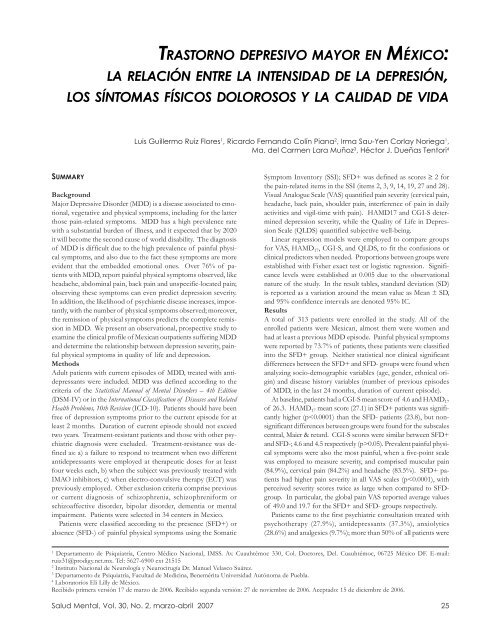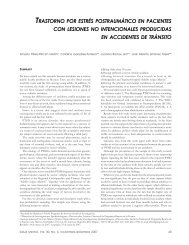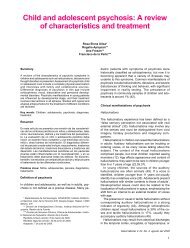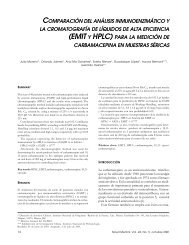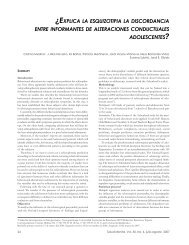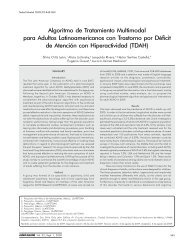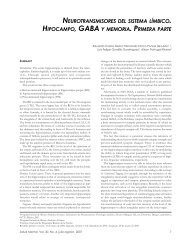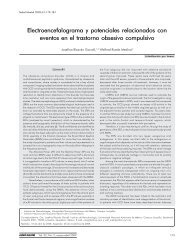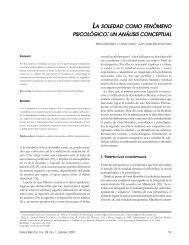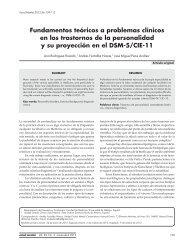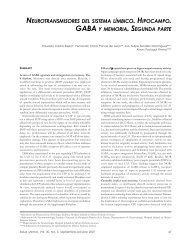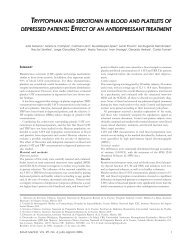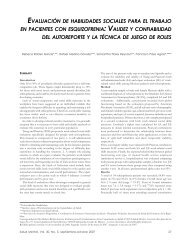trastorno depresivo mayor en méxico: la relación entre la intensidad ...
trastorno depresivo mayor en méxico: la relación entre la intensidad ...
trastorno depresivo mayor en méxico: la relación entre la intensidad ...
You also want an ePaper? Increase the reach of your titles
YUMPU automatically turns print PDFs into web optimized ePapers that Google loves.
TRASTORNO DEPRESIVO MAYOR EN MÉXICO:<br />
LA RELACIÓN ENTRE LA INTENSIDAD DE LA DEPRESIÓN,<br />
LOS SÍNTOMAS FÍSICOS DOLOROSOS Y LA CALIDAD DE VIDA<br />
Luis Guillermo Ruiz Flores 1 , Ricardo Fernando Colín Piana 2 , Irma Sau-Y<strong>en</strong> Cor<strong>la</strong>y Noriega 1 ,<br />
Ma. del Carm<strong>en</strong> Lara Muñoz 3 , Héctor J. Dueñas T<strong>en</strong>tori 4<br />
SUMMARY<br />
Background<br />
Major Depressive Disorder (MDD) is a disease associated to emotional,<br />
vegetative and physical symptoms, including for the <strong>la</strong>tter<br />
those pain-re<strong>la</strong>ted symptoms. MDD has a high preval<strong>en</strong>ce rate<br />
with a substantial burd<strong>en</strong> of illness, and it expected that by 2020<br />
it will become the second cause of world disability. The diagnosis<br />
of MDD is difficult due to the high preval<strong>en</strong>ce of painful physical<br />
symptoms, and also due to the fact these symptoms are more<br />
evid<strong>en</strong>t that the embedded emotional ones. Over 76% of pati<strong>en</strong>ts<br />
with MDD, report painful physical symptoms observed, like<br />
headache, abdominal pain, back pain and unspecific-located pain;<br />
observing these symptoms can ev<strong>en</strong> predict depression severity.<br />
In addition, the likelihood of psychiatric disease increases, importantly,<br />
with the number of physical symptoms observed; moreover,<br />
the remission of physical symptoms predicts the complete remission<br />
in MDD. We pres<strong>en</strong>t an observational, prospective study to<br />
examine the clinical profile of Mexican outpati<strong>en</strong>ts suffering MDD<br />
and determine the re<strong>la</strong>tionship betwe<strong>en</strong> depression severity, painful<br />
physical symptoms in quality of life and depression.<br />
Methods<br />
Adult pati<strong>en</strong>ts with curr<strong>en</strong>t episodes of MDD, treated with antidepressants<br />
were included. MDD was defined according to the<br />
criteria of the Statistical Manual of M<strong>en</strong>tal Disorders – 4th Edition<br />
(DSM-IV) or in the International C<strong>la</strong>ssification of Diseases and Re<strong>la</strong>ted<br />
Health Problems, 10th Revision (ICD-10). Pati<strong>en</strong>ts should have be<strong>en</strong><br />
free of depression symptoms prior to the curr<strong>en</strong>t episode for at<br />
least 2 months. Duration of curr<strong>en</strong>t episode should not exceed<br />
two years. Treatm<strong>en</strong>t-resistant pati<strong>en</strong>ts and those with other psychiatric<br />
diagnosis were excluded. Treatm<strong>en</strong>t-resistance was defined<br />
as: a) a failure to respond to treatm<strong>en</strong>t wh<strong>en</strong> two differ<strong>en</strong>t<br />
antidepressants were employed at therapeutic doses for at least<br />
four weeks each, b) wh<strong>en</strong> the subject was previously treated with<br />
IMAO inhibitors, c) wh<strong>en</strong> electro-convulsive therapy (ECT) was<br />
previously employed. Other exclusion criteria comprise previous<br />
or curr<strong>en</strong>t diagnosis of schizophr<strong>en</strong>ia, schizophr<strong>en</strong>iform or<br />
schizoaffective disorder, bipo<strong>la</strong>r disorder, dem<strong>en</strong>tia or m<strong>en</strong>tal<br />
impairm<strong>en</strong>t. Pati<strong>en</strong>ts were selected in 34 c<strong>en</strong>ters in Mexico.<br />
Pati<strong>en</strong>ts were c<strong>la</strong>ssified according to the pres<strong>en</strong>ce (SFD+) or<br />
abs<strong>en</strong>ce (SFD-) of painful physical symptoms using the Somatic<br />
Symptom Inv<strong>en</strong>tory (SSI); SFD+ was defined as scores ≥ 2 for<br />
the pain-re<strong>la</strong>ted items in the SSI (items 2, 3, 9, 14, 19, 27 and 28).<br />
Visual Analogue Scale (VAS) quantified pain severity (cervical pain,<br />
headache, back pain, shoulder pain, interfer<strong>en</strong>ce of pain in daily<br />
activities and vigil-time with pain). HAMD17 and CGI-S determined<br />
depression severity, while the Quality of Life in Depression<br />
Scale (QLDS) quantified subjective well-being.<br />
Linear regression models were employed to compare groups<br />
for VAS, HAMD 17 , CGI-S, and QLDS, to fit the confusions or<br />
clinical predictors wh<strong>en</strong> needed. Proportions betwe<strong>en</strong> groups were<br />
established with Fisher exact test or logistic regression. Significance<br />
levels were established at 0.005 due to the observational<br />
nature of the study. In the result tables, standard deviation (SD)<br />
is reported as a variation around the mean value as Mean ± SD,<br />
and 95% confid<strong>en</strong>ce intervals are d<strong>en</strong>oted 95% IC.<br />
Results<br />
A total of 313 pati<strong>en</strong>ts were <strong>en</strong>rolled in the study. All of the<br />
<strong>en</strong>rolled pati<strong>en</strong>ts were Mexican, almost them were wom<strong>en</strong> and<br />
had at least a previous MDD episode. Painful physical symptoms<br />
were reported by 73.7% of pati<strong>en</strong>ts, these pati<strong>en</strong>ts were c<strong>la</strong>ssified<br />
into the SFD+ group. Neither statistical nor clinical significant<br />
differ<strong>en</strong>ces betwe<strong>en</strong> the SFD+ and SFD- groups were found wh<strong>en</strong><br />
analyzing socio-demographic variables (age, g<strong>en</strong>der, ethnical origin)<br />
and disease history variables (number of previous episodes<br />
of MDD, in the <strong>la</strong>st 24 months, duration of curr<strong>en</strong>t episode).<br />
At baseline, pati<strong>en</strong>ts had a CGI-S mean score of 4.6 and HAMD 17<br />
of 26.3. HAMD 17 mean score (27.1) in SFD+ pati<strong>en</strong>ts was significantly<br />
higher (p0.05). Preval<strong>en</strong>t painful physical<br />
symptoms were also the most painful, wh<strong>en</strong> a five-point scale<br />
was employed to measure severity, and comprised muscu<strong>la</strong>r pain<br />
(84.9%), cervical pain (84.2%) and headache (83.5%). SFD+ pati<strong>en</strong>ts<br />
had higher pain severity in all VAS scales (p
not taking any drugs or receiving psychotherapy for treatm<strong>en</strong>t of<br />
MDD at baseline. Analgesics were used only by 9.7% of pati<strong>en</strong>ts<br />
for the treatm<strong>en</strong>t of painful physical symptoms in their curr<strong>en</strong>t<br />
MDD episode. No significant differ<strong>en</strong>ces betwe<strong>en</strong> groups were<br />
found wh<strong>en</strong> comparing the use of psychotherapy, antidepressants,<br />
anxiolytics, antipsychotics, mood stabilizers or analgesics. Quality<br />
of life was poor for all pati<strong>en</strong>ts, but significantly worse in the<br />
SFD+ group than in the SFD- group (QLDS scores of 23.2 and<br />
20.0 respectively, p
Pa<strong>la</strong>bras c<strong>la</strong>ve: Trastorno Depresivo Mayor, síntomas físicos dolorosos<br />
asociados a <strong>la</strong> depresión, calidad de vida, Inv<strong>en</strong>tario de<br />
Síntomas Somáticos, Esca<strong>la</strong> de Hamilton de 17 apartados.<br />
INTRODUCCIÓN<br />
El Trastorno Depresivo Mayor (TDM) es una <strong>en</strong>fermedad<br />
psiquiátrica asociada a síntomas emocionales,<br />
vegetativos y físicos, <strong>en</strong>tre los que se <strong>en</strong>cu<strong>en</strong>tran los de<br />
naturaleza dolorosa que se sobrepon<strong>en</strong>. El TDM se<br />
asocia a una alta preval<strong>en</strong>cia y a una importante carga <strong>en</strong><br />
términos humanos y económicos, por lo que <strong>la</strong> OMS ha<br />
estimado que esta <strong>en</strong>fermedad se convertirá <strong>en</strong> <strong>la</strong> segunda<br />
causa de discapacidad hacia el año 2020 (1, 13, 23).<br />
No obstante <strong>la</strong> alta preval<strong>en</strong>cia del TDM, se especu<strong>la</strong><br />
que esta <strong>en</strong>fermedad es subdiagnosticada, ya que su<br />
reconocimi<strong>en</strong>to puede dificultarse debido a <strong>la</strong> alta frecu<strong>en</strong>cia<br />
de síntomas físicos asociados, sobre todo de<br />
naturaleza dolorosa, mismos que pued<strong>en</strong> ser más evid<strong>en</strong>tes<br />
que los síntomas emocionales subyac<strong>en</strong>tes (20).<br />
Estudios actuales reve<strong>la</strong>n que hasta el 76% de los paci<strong>en</strong>tes<br />
con depresión reportan síntomas físicos dolorosos<br />
como cefalea, dolor abdominal, dolor lumbar y<br />
dolor sin localización precisa (5, 20). Además, se ha<br />
demostrado que <strong>la</strong>s molestias musculoesqueléticas inespecíficas,<br />
el dolor lumbar y el dolor precordial predic<strong>en</strong><br />
<strong>la</strong> int<strong>en</strong>sidad de <strong>la</strong> depresión (12). La probabilidad<br />
de <strong>en</strong>fermedad psiquiátrica se increm<strong>en</strong>ta dramáticam<strong>en</strong>te<br />
con el número de síntomas físicos (21), <strong>en</strong> tanto<br />
que <strong>la</strong> resolución de los síntomas físicos es un predictor<br />
importante de <strong>la</strong> remisión <strong>en</strong> el tratami<strong>en</strong>to del<br />
TDM (25). Los paci<strong>en</strong>tes que alcanzan <strong>la</strong> remisión completa<br />
ti<strong>en</strong><strong>en</strong> m<strong>en</strong>os probabilidades de recaer (27).<br />
La alta preval<strong>en</strong>cia de síntomas físicos dolorosos asociados<br />
a <strong>la</strong> depresión, se ha establecido <strong>en</strong> estudios clínicos<br />
durante <strong>la</strong> práctica de primer nivel de contacto,<br />
tanto <strong>en</strong> Estados Unidos como <strong>en</strong> Europa (4).<br />
En el pres<strong>en</strong>te estudio describimos el perfil epidemiológico<br />
de una muestra de paci<strong>en</strong>tes mexicanos que<br />
pres<strong>en</strong>tan TDM, con énfasis <strong>en</strong> <strong>la</strong>s re<strong>la</strong>ciones <strong>en</strong>tre <strong>la</strong><br />
depresión, los síntomas físicos dolorosos asociados y<br />
su calidad de vida.<br />
MATERIAL Y MÉTODOS<br />
Paci<strong>en</strong>tes<br />
Para el estudio se reclutaron paci<strong>en</strong>tes no hospitalizados,<br />
de un mínimo de 18 años o más, de ambos géneros,<br />
que cumplieran con los criterios de selección y los criterios<br />
diagnósticos de TDM <strong>en</strong> el Statistical Manual of M<strong>en</strong>tal<br />
Disorders – 4th Edition (DSM-IV) o con los diagnósticos<br />
de <strong>la</strong> International C<strong>la</strong>ssification of Diseases and Re<strong>la</strong>ted<br />
Health Problems, 10 th Revision (ICD-10). Se requería que los<br />
paci<strong>en</strong>tes pres<strong>en</strong>taran un episodio único o recurr<strong>en</strong>te de<br />
TDM y que fueran tratados con medicam<strong>en</strong>tos anti<strong>depresivo</strong>s.<br />
Previo al episodio actual, los paci<strong>en</strong>tes debían<br />
haber estado libres de cualquier síntoma de depresión<br />
por lo m<strong>en</strong>os dos meses, y <strong>la</strong> duración del episodio actual<br />
no debía exceder dos años continuos. Se excluyeron paci<strong>en</strong>tes<br />
resist<strong>en</strong>tes al tratami<strong>en</strong>to anti<strong>depresivo</strong> (definido<br />
esto como <strong>la</strong> fal<strong>la</strong> para responder a dos c<strong>la</strong>ses difer<strong>en</strong>tes<br />
de anti<strong>depresivo</strong>s, con una dosis aceptable por lo m<strong>en</strong>os<br />
durante 4 semanas para cada uno; si se les había prescrito<br />
un inhibidor de <strong>la</strong> monoamino-oxidasa [IMAO] <strong>en</strong> alguna<br />
ocasión, o si habían necesitado terapia electroconvulsiva<br />
[ECT])(28). Otros criterios de exclusión fueron: cualquier<br />
diagnóstico previo o actual de esquizofr<strong>en</strong>ia, <strong>trastorno</strong><br />
esquizofr<strong>en</strong>iforme, <strong>trastorno</strong> esquizoafectivo, <strong>trastorno</strong><br />
bipo<strong>la</strong>r, dem<strong>en</strong>cia o retraso m<strong>en</strong>tal.<br />
Diseño del estudio<br />
Este estudio observacional involucró a 313 paci<strong>en</strong>tes<br />
reclutados por 34 investigadores, de 34 c<strong>en</strong>tros de estudio<br />
<strong>en</strong> México. En este estudio se reportan <strong>la</strong>s observaciones<br />
iniciales. Un Comité de Etica c<strong>en</strong>tral, pert<strong>en</strong>eci<strong>en</strong>te<br />
a una institución <strong>en</strong>cargada de realizar Investigación<br />
Clínica Aplicada, aprobó el protocolo del<br />
estudio, <strong>la</strong>s Formas de Reporte y el Cons<strong>en</strong>timi<strong>en</strong>to<br />
para <strong>la</strong> Diseminación de <strong>la</strong> Información. Cada paci<strong>en</strong>te<br />
dió su cons<strong>en</strong>timi<strong>en</strong>to antes de iniciar cualquier procedimi<strong>en</strong>to<br />
del estudio.<br />
Instrum<strong>en</strong>tos<br />
Los paci<strong>en</strong>tes que experim<strong>en</strong>taban síntomas físicos dolorosos<br />
(SFD+) se difer<strong>en</strong>ciaron de aquellos sin síntomas<br />
físicos dolorosos (SFD-) por una puntuación promedio<br />
≥ 2 para los apartados que hac<strong>en</strong> refer<strong>en</strong>cia al<br />
dolor de acuerdo al Inv<strong>en</strong>tario de Síntomas Somáticos<br />
(SSI; puntos 2, 3, 9, 14, 19, 27 y 28)(21). Se midió con <strong>la</strong><br />
VAS <strong>la</strong> int<strong>en</strong>sidad del dolor (6), mi<strong>en</strong>tras que <strong>la</strong> int<strong>en</strong>sidad<br />
de <strong>la</strong> depresión fue determinada de acuerdo a <strong>la</strong> Esca<strong>la</strong><br />
para Depresión de Hamilton de 17 apartados<br />
(HAMD 17 ) (16) y <strong>la</strong> Esca<strong>la</strong> de Impresión Clínica Global,<br />
<strong>en</strong> el apartado de gravedad (CGI-S) (15). Con <strong>la</strong> Esca<strong>la</strong><br />
de Calidad de Vida <strong>en</strong> <strong>la</strong> Depresión (QLDS) se midió el<br />
bi<strong>en</strong>estar subjetivo (17). Antes de ingresar al paci<strong>en</strong>te <strong>en</strong><br />
el estudio, <strong>en</strong> cada caso se registró el tipo de tratami<strong>en</strong>to<br />
previam<strong>en</strong>te recibido, y se incluyó <strong>la</strong> psicoterapia y <strong>la</strong> c<strong>la</strong>se<br />
de medicam<strong>en</strong>to(s) prescrito (s) para <strong>la</strong> depresión.<br />
Métodos estadísticos<br />
Para <strong>la</strong>s variables continuas (VAS, CGI-S, HAMD 17 y<br />
QLDS), <strong>la</strong>s comparaciones se hicieron mediante modelos<br />
de regresión lineal, ajustados a los modelos lineales<br />
específicos, para los casos <strong>en</strong> los que <strong>la</strong> distribución no<br />
fuera normal. Cuando era apropiado, se hicieron ajustes<br />
Salud M<strong>en</strong>tal, Vol. 30, No. 2, marzo-abril 2007 27
para los factores de confusión o para los predictores clínicos<br />
relevantes. También fueron determinadas <strong>la</strong>s re<strong>la</strong>ciones<br />
<strong>en</strong>tre VAS, CGI-S, HAMD 17 , variables demográficas<br />
y sus efectos <strong>en</strong> QLDS mediante el uso de modelos lineales<br />
y se consideró a todas <strong>la</strong>s variables como continuas.<br />
Se empleó <strong>la</strong> prueba exacta de Fisher para comparar<br />
<strong>la</strong>s proporciones de paci<strong>en</strong>tes con o sin síntomas físicos<br />
dolorosos asociados. Cuando <strong>la</strong> información de<br />
<strong>la</strong>s respuestas era dicotómica, se usó <strong>la</strong> regresión logística<br />
para determinar <strong>la</strong> razón de momios (odds ratio).<br />
Debido al número de hipótesis que t<strong>en</strong>drían que ser<br />
probadas y a <strong>la</strong> naturaleza no contro<strong>la</strong>da de los estudios<br />
observacionales, se establecieron <strong>mayor</strong>es exig<strong>en</strong>cias<br />
<strong>en</strong> los análisis estadísticos. Así, los niveles de significancia<br />
se establecieron post hoc a 3 2 0.7 2 0 0 0<br />
1 - 3 108 35.9 78 34.7 29 38.7<br />
Ninguno 191 63.5 145 64.4 46 61.3<br />
Duración del episodio actual bc (n=311)<br />
>1 – 2 años 15 4.8 11 4.8 4 4.9<br />
>6 meses – 1 año 31 10.0 26 11.4 5 6.2<br />
CUADRO 2. Int<strong>en</strong>sidad de <strong>la</strong> depresión medida por CGI-S y HAMD 17 , para el total de <strong>la</strong> pob<strong>la</strong>ción del estudio. Los paci<strong>en</strong>tes<br />
fueron separados <strong>en</strong> grupos con Síntomas Físicos Dolorosos Positivos (SFD+) y Negativos (SFD-)<br />
Total SFD+ SFD- Difer<strong>en</strong>cia Media Valor p<br />
Medida Media (DE) n Media (DE) n Media (DE) n (IC 95%)<br />
CGI-S 4.6 (0.8) 310 4.6 (0.8) 227 4.5 (0.9) 82 0.13 (-0.07, 0.33) N.S.<br />
HAMD 17 26.3 (6.1) 306 27.1 (5.7) 227 23.8 (6.5) 78 3.31 (1.78, 4.84) < 0.0001<br />
HAMD; subesca<strong>la</strong><br />
C<strong>en</strong>tral 10.5 (2.7) 312 10.6 (2.6) 230 10.3 (2.8) 81 0.31 (-0.37, 1.0) N.S.<br />
Maier 13.0 (3.1) 311 13.2 (3.1) 230 12.3 (3.3) 80 0.9 (0.11, 1.70) 0.026<br />
Ansiedad 9.2 (2.6) 309 9.7 (2.3) 228 7.8 (2.9) 80 1.83 (1.20, 2.45) < 0.0001<br />
Retardo 8.4 (2.2) 311 8.3 (2.2) 228 8.4 (2.2) 82 -0.07 (-0.64, 0.49) N.S.<br />
Sueño 3.4 (1.7) 312 3.6 (1.6) 229 2.7 (1.7) 82 0.86 (0.45, 1.26) < 0.0001<br />
DE = Desviación estándar<br />
IC 95% = Intervalo de confianza del 95%<br />
N.S. = No significativo<br />
cervical (84.2%), y cefalea (83.5%) (figura 2). Los síntomas<br />
físicos más comunes también fueron los de <strong>mayor</strong><br />
int<strong>en</strong>sidad; <strong>en</strong> una esca<strong>la</strong> de cinco puntos, una proporción<br />
sustancial de paci<strong>en</strong>tes reportó molestia de 4 o 5<br />
(“bastante” a “mucho”) <strong>en</strong> <strong>la</strong> semana previa a <strong>la</strong> evaluación,<br />
de acuerdo a los apartados de dolores muscu<strong>la</strong>res<br />
(34.9%), dolor cervical (38.7%) o cefalea (37.1%). Esto<br />
correspondió a puntuaciones medias de SSI de 2.98<br />
(±1.22), 3.04 (±1.32) y 2.96 (±1.28) de un máximo de 5<br />
puntos. Para dolor abdominal sólo 9.3% de los paci<strong>en</strong>tes<br />
reportó ser afectado de “un poco” a “bastante”; este<br />
síntoma se pres<strong>en</strong>tó sólo <strong>en</strong> el 46% de los paci<strong>en</strong>tes.<br />
Los paci<strong>en</strong>tes SFD+ pres<strong>en</strong>taron significativam<strong>en</strong>te<br />
una <strong>mayor</strong> int<strong>en</strong>sidad global del dolor (p
60<br />
-10<br />
50<br />
Puntuación <strong>en</strong> VAS<br />
40<br />
30<br />
20<br />
10<br />
0<br />
VAS global Cefalea Lumbalgia Dolor de<br />
hombro<br />
Fig.3. Int<strong>en</strong>sidad del dolor <strong>en</strong> <strong>la</strong> Esca<strong>la</strong> Análoga Visual (VAS),<br />
por grupo.<br />
Calidad de vida<br />
La puntuación promedio de QLDS fue 22.4 (±7.4).<br />
Los paci<strong>en</strong>tes SFD+ tuvieron puntuaciones promedio<br />
(23.2 ± 6.6) significativam<strong>en</strong>te <strong>mayor</strong>es a <strong>la</strong>s del grupo<br />
de paci<strong>en</strong>tes SFD- (20.0 ± 8.9, p
ción de <strong>la</strong> esca<strong>la</strong> total y <strong>en</strong> <strong>la</strong>s subesca<strong>la</strong>s de Ansiedad<br />
y Sueño del HAMD 17 , con <strong>mayor</strong>es puntajes que los<br />
paci<strong>en</strong>tes SFD-. En cambio, <strong>en</strong> <strong>la</strong> esca<strong>la</strong> CGI-S no hubo<br />
difer<strong>en</strong>cias <strong>en</strong>tre los grupos SFD+ y SFD-. Al tratarse<br />
del mismo médico y del mismo paci<strong>en</strong>te, <strong>la</strong> disparidad<br />
<strong>en</strong>tre <strong>la</strong> calificación de <strong>la</strong>s dos esca<strong>la</strong>s nos permite ver<br />
que existe una difer<strong>en</strong>cia notable <strong>en</strong>tre <strong>la</strong> manera <strong>en</strong> <strong>la</strong><br />
que evalúa el psiquiatra mexicano, desde el punto de<br />
vista clínico, <strong>la</strong> int<strong>en</strong>sidad del cuadro <strong>depresivo</strong> y <strong>la</strong><br />
forma <strong>en</strong> que lo hace, cuando <strong>la</strong> evaluación es semiestructurada<br />
mediante <strong>la</strong> calificación de un instrum<strong>en</strong>to;<br />
esto hace especialm<strong>en</strong>te importante <strong>la</strong> id<strong>en</strong>tificación<br />
de los síntomas físicos dolorosos asociados <strong>en</strong> <strong>la</strong> depresión,<br />
que se <strong>en</strong>cu<strong>en</strong>tran c<strong>la</strong>ram<strong>en</strong>te re<strong>la</strong>cionados con<br />
una <strong>mayor</strong> gravedad del cuadro clínico.<br />
En <strong>la</strong> bibliografía internacional se ha reportado que<br />
hasta 76% de los paci<strong>en</strong>tes deprimidos at<strong>en</strong>didos <strong>en</strong><br />
un primer nivel de at<strong>en</strong>ción, experim<strong>en</strong>tó síntomas físicos<br />
dolorosos (5, 20) y que <strong>la</strong>s probabilidades de un<br />
<strong>trastorno</strong> psiquiátrico se increm<strong>en</strong>tan dramáticam<strong>en</strong>te<br />
conforme éstos aum<strong>en</strong>tan <strong>en</strong> número (21). También<br />
se ha reportado con frecu<strong>en</strong>cia que <strong>en</strong> el caso de los<br />
paci<strong>en</strong>tes que acud<strong>en</strong> a consulta de medicina g<strong>en</strong>eral,<br />
muchos desestiman los síntomas psicosociales y resaltan<br />
el dolor como su molestia primaria o incluso única<br />
(13). En un estudio internacional con 1,146 paci<strong>en</strong>tes<br />
evaluados con TDM <strong>en</strong> <strong>la</strong> práctica de primer contacto,<br />
69% reportó síntomas físicos como <strong>la</strong> única razón para<br />
acudir a consulta (26). Además, Kirmayer y cols. (1993),<br />
<strong>en</strong>contraron que hasta 80% de los paci<strong>en</strong>tes deprimidos,<br />
pres<strong>en</strong>tó exclusivam<strong>en</strong>te síntomas físicos (20).<br />
En el pres<strong>en</strong>te estudio, cerca de tres cuartas partes<br />
de los paci<strong>en</strong>tes con depresión t<strong>en</strong>ían síntomas físicos<br />
dolorosos (SFD+), con <strong>mayor</strong> gravedad <strong>en</strong> el dolor,<br />
medida <strong>en</strong> todos los apartados de <strong>la</strong> VAS, <strong>en</strong> comparación<br />
con los paci<strong>en</strong>tes SFD-. Esto indica que los síntomas<br />
dolorosos asociados a <strong>la</strong> depresión, pued<strong>en</strong> ser<br />
específicam<strong>en</strong>te caracterizados y se expresan como difer<strong>en</strong>tes<br />
tipos de dolor: cefalea, lumbalgia o dolor cervical.<br />
El Inv<strong>en</strong>tario de Síntomas Somáticos (SSI) que<br />
determina <strong>la</strong> pres<strong>en</strong>cia de síntomas físicos dolorosos,<br />
fue ll<strong>en</strong>ado por los mismos paci<strong>en</strong>tes, refiri<strong>en</strong>do<br />
<strong>la</strong> sintomatología de <strong>la</strong> semana previa a <strong>la</strong> visita.<br />
En el grupo de estudio, los tratami<strong>en</strong>tos más frecu<strong>en</strong>tes<br />
previos a <strong>la</strong> primera consulta con el psiquiatra, fueron<br />
los anti<strong>depresivo</strong>s, <strong>la</strong> psicoterapia y los ansiolíticos,<br />
sin difer<strong>en</strong>cia <strong>en</strong>tre los grupos. Estudios previos han<br />
reve<strong>la</strong>do que los paci<strong>en</strong>tes deprimidos con síntomas físicos<br />
toman más medicam<strong>en</strong>tos que aquellos sin estos<br />
síntomas (11). Es importante resaltar que más de <strong>la</strong> mitad<br />
de los paci<strong>en</strong>tes llegó a su primera consulta sin tratami<strong>en</strong>to<br />
alguno, y que el uso de anti<strong>depresivo</strong>s no llega a<br />
40% de los paci<strong>en</strong>tes. Cabe ac<strong>la</strong>rar que no se int<strong>en</strong>tó<br />
detal<strong>la</strong>r los tratami<strong>en</strong>tos previos, particu<strong>la</strong>rm<strong>en</strong>te los farmacológicos<br />
y <strong>la</strong>s dosis empleadas, <strong>la</strong> duración y el apego<br />
a los mismos; si bi<strong>en</strong> no se <strong>en</strong>contraron difer<strong>en</strong>cias<br />
globales <strong>en</strong> los patrones de tratami<strong>en</strong>to <strong>en</strong>tre los grupos<br />
SFD+ y SFD-, estos aspectos podrían t<strong>en</strong>er un aspecto<br />
difer<strong>en</strong>cial <strong>en</strong> <strong>la</strong>s observaciones.<br />
Para una considerable proporción de los paci<strong>en</strong>tes con<br />
TDM, <strong>la</strong> eficacia de <strong>la</strong> farmacoterapia no es óptima (7)<br />
ya que <strong>en</strong>tre 30 y 40% de los paci<strong>en</strong>tes logra una remisión<br />
completa de los síntomas con el anti<strong>depresivo</strong> seleccionado<br />
inicialm<strong>en</strong>te (14). Fava (2003) reportó que<br />
mi<strong>en</strong>tras los síntomas psicológicos respond<strong>en</strong> a los anti<strong>depresivo</strong>s<br />
disponibles, los síntomas físicos no respond<strong>en</strong><br />
totalm<strong>en</strong>te hasta <strong>la</strong> remisión (10), por lo que <strong>la</strong> falta<br />
de eficacia podría atribuirse a <strong>la</strong> fal<strong>la</strong> <strong>en</strong> el manejo de los<br />
síntomas dolorosos de <strong>la</strong> depresión (19). La capacidad<br />
de resolver los síntomas físicos dolorosos es un fuerte<br />
predictor de <strong>la</strong> remisión completa del TDM (25). Además<br />
los paci<strong>en</strong>tes que alcanzan <strong>la</strong> remisión completa ti<strong>en</strong><strong>en</strong><br />
m<strong>en</strong>os probabilidades de recaer (27). Por lo tanto,<br />
<strong>la</strong> evid<strong>en</strong>cia sugiere que el tratami<strong>en</strong>to de los ámbitos<br />
emocionales y físicos de <strong>la</strong> depresión lleva a los paci<strong>en</strong>tes<br />
a una <strong>mayor</strong> tasa de remisión.<br />
La meta a <strong>la</strong>rgo p<strong>la</strong>zo <strong>en</strong> el tratami<strong>en</strong>to del TDM es<br />
asegurarse que los paci<strong>en</strong>tes mant<strong>en</strong>gan su funcionalidad,<br />
por lo que <strong>la</strong> definición y evaluación de <strong>la</strong> calidad<br />
de vida es un aspecto muy importante <strong>en</strong> <strong>la</strong> psiquiatría<br />
moderna (3). La calidad de vida es una construcción<br />
multidim<strong>en</strong>sional que <strong>en</strong> su evaluación incorpora compon<strong>en</strong>tes<br />
de <strong>la</strong>s áreas emocional, física y social, por lo<br />
tanto se trata de una medida subjetiva y resulta imperativo<br />
que <strong>la</strong> evaluación incluya el reporte del propio<br />
paci<strong>en</strong>te sobre su bi<strong>en</strong>estar (2).<br />
La esca<strong>la</strong> de calidad de vida para depresión (QLDS),<br />
es un cuestionario de 34 apartados, diseñado para determinar<br />
<strong>la</strong> habilidad y capacidad del individuo para satifacer<br />
necesidades humanas cotidianas. Se asume que <strong>la</strong><br />
calidad de vida es <strong>mayor</strong> cuando <strong>la</strong> <strong>mayor</strong>ía de <strong>la</strong>s necesidades<br />
del individuo están satisfechas (22). Las respuestas<br />
del paci<strong>en</strong>te que están asociadas con una calidad de<br />
vida adversa, contribuy<strong>en</strong> con un punto <strong>en</strong> <strong>la</strong> evaluación<br />
total de QLDS. Consecu<strong>en</strong>tem<strong>en</strong>te una calidad de<br />
vida pobre se refleja <strong>en</strong> una puntuación alta <strong>en</strong> QLDS.<br />
Al inicio del estudio <strong>la</strong> <strong>mayor</strong>ía de los paci<strong>en</strong>tes experim<strong>en</strong>taba<br />
una calidad de vida pobre. Los paci<strong>en</strong>tes<br />
SFD+ t<strong>en</strong>ían un <strong>mayor</strong> deterioro <strong>en</strong> su calidad de vida<br />
que aquellos del grupo SFD-.<br />
CONCLUSIONES<br />
Este estudio confirma <strong>la</strong> alta preval<strong>en</strong>cia de síntomas<br />
físicos dolorosos <strong>en</strong> los paci<strong>en</strong>tes mexicanos con TDM.<br />
Es notable <strong>la</strong> concordancia y <strong>la</strong> consist<strong>en</strong>cia de <strong>la</strong>s cifras<br />
publicadas <strong>en</strong> <strong>la</strong> bibliografía internacional para los<br />
Salud M<strong>en</strong>tal, Vol. 30, No. 2, marzo-abril 2007 31
paci<strong>en</strong>tes deprimidos at<strong>en</strong>didos <strong>en</strong> el primer nivel de at<strong>en</strong>ción<br />
y los paci<strong>en</strong>tes mexicanos at<strong>en</strong>didos por psiquiatras,<br />
lo que sugiere que se trata del mismo tipo de paci<strong>en</strong>te,<br />
pero reconocido nosológicam<strong>en</strong>te con difer<strong>en</strong>tes<br />
ópticas; esto probablem<strong>en</strong>te dep<strong>en</strong>de del sesgo clínico<br />
y del área de <strong>la</strong> medicina que se practique, por lo que<br />
se hace necesario el reconocimi<strong>en</strong>to de <strong>la</strong> dim<strong>en</strong>sión física<br />
de <strong>la</strong> depresión como un factor de importancia para<br />
el abordaje diagnóstico y terapéutico del paci<strong>en</strong>te deprimido.<br />
P<strong>en</strong>samos que el proceso diagnóstico <strong>en</strong> <strong>la</strong> práctica<br />
rutinaria del TDM se puede b<strong>en</strong>eficiar importantem<strong>en</strong>te<br />
al reconocer <strong>la</strong> alta preval<strong>en</strong>cia de síntomas físicos<br />
dolorosos asociados a esta <strong>en</strong>fermedad.<br />
Agradecimi<strong>en</strong>tos<br />
Los autores agradec<strong>en</strong> a los sigui<strong>en</strong>tes investigadores su participación<br />
<strong>en</strong> este trabajo: Adriana Acuña, Gonzalo Alemán Cruz,<br />
José de Jesús Castillo Ruíz, Antonio Celis Perdomo, Juan Bautista<br />
Corral García, Ricardo Chapa Vázquez, Omar Kawas<br />
Valle, Arturo Leonel Garza Vargas, María Liliana Toledo,<br />
Eduardo Angel Madrigal de León, Pa<strong>la</strong>s At<strong>en</strong>ea Martínez Sa<strong>la</strong>zar,<br />
José Humberto Nicolini Sánchez, María Magdal<strong>en</strong>a<br />
Ocampo Reg<strong>la</strong>, Mario Alberto Olivares Herver, Alfonso Ontiveros<br />
Sánchez de <strong>la</strong> Barquera, Felipe de Jesús Ortega Zarzosa,<br />
Francisco Páez Agraz, Jaime Raull Ariza, Br<strong>en</strong>da Rivera<br />
Meza, Armando Rodríguez Jacobo, Luis Xavier Sandoval García,<br />
Jorge Saucedo Pérez, Ricardo Secín Diep, Javier Sepúlveda<br />
Amor, Carlos Serrano Gómez, Guillermo Tapia Paniagua, José<br />
Alejandro Torre Sar<strong>la</strong>t, Adrian Vargas Montiel, Martín Felipe<br />
Vázquez Estupiñán, Juan Luis Vázquez Hernández.<br />
REFERENCIAS<br />
1. AMERICAN PSYCHIATRIC ASSOCIATION: Diagnostic and<br />
Statistical Manual of M<strong>en</strong>tal Disorders. Cuarta edición. Washington,<br />
1994.<br />
2. AWAD AG, VORUGANTI LN: Interv<strong>en</strong>tion research in psychosis:<br />
issues re<strong>la</strong>ted to the assessm<strong>en</strong>t of quality of life. Schizophr<br />
Bull, 26:557-564, 2000.<br />
3. AWAD AG, VORUGANTI LN: Quality of life and new antipsychotics<br />
in schizophr<strong>en</strong>ia. Are pati<strong>en</strong>ts better off? Int J<br />
Soc Psychiatry, 45:268-275, 1999.<br />
4. BRIDGES KW, GOLDBERG DP: Somatic pres<strong>en</strong>tation of<br />
DSM III psychiatric disorders in primary care. J Psychosomatic<br />
Research, 29:563-569, 1985.<br />
5. CORRUBLE E, GUELFI JD: Pain comp<strong>la</strong>ints in depressed<br />
inpati<strong>en</strong>ts. Psychopathology, 33:307-309, 2000.<br />
6. DELOACH LJ, HIGGINS MS, CAPLAN AB y cols.: The<br />
visual analog scale in the immediate postoperative period: intrasubject<br />
variability and corre<strong>la</strong>tion with a numeric scale.<br />
Anesthesia Analgesia, 86:102-106, 1998.<br />
7. DETKE MJ, LU Y, GOLDSTEIN DJ, MCNAMARA RK,<br />
DEMITRACK MA: Duloxetine 60 mg once daily dosing versus<br />
p<strong>la</strong>cebo in the acute treatm<strong>en</strong>t of major depression. J<br />
Psychiatric Research, 36(6):383-390, 2002.<br />
8. DEVINS GM, BEISER M, DION R y cols.: Cross-cultural<br />
measurem<strong>en</strong>ts of psychological well-being: the psychometric<br />
equival<strong>en</strong>ce of Cantonese, Vietnamese, and Laotian trans<strong>la</strong>tions<br />
of the Affect Ba<strong>la</strong>nce Scale. American J Public Health,<br />
32<br />
87:794-799, 1997.<br />
9. ESCOBAR JI, GOMEZ J, TUASON VB: Depressive ph<strong>en</strong>om<strong>en</strong>ology<br />
in North and South American pati<strong>en</strong>ts. American J<br />
Psychiatry, 140:47-51, 1983.<br />
10. FAVA M: Depression with physical symptoms: treating to<br />
remission. J Clin Psychiatry, 64(Supl):7:24-28, 2003.<br />
11. FRITZSCHE K, SANDHOLZER H, BRUCKS U y cols.:<br />
Psychosocial care by g<strong>en</strong>eral practitioners—where are the<br />
problems? Results of a demonstration project on quality managem<strong>en</strong>t<br />
in psychosocial primary care. International J Psychiatry<br />
Medicine, 29:395-409, 1999.<br />
12. GERBER PD, BARRETT JE, BARRETT JA y cols.: The re<strong>la</strong>tionship<br />
of pres<strong>en</strong>ting physical comp<strong>la</strong>ints to depressive symptoms<br />
in primary care pati<strong>en</strong>ts. J G<strong>en</strong> Intern Me, 7:170-173, 1992.<br />
13. GREDEN JF: Physical symptoms of depression: unmet<br />
needs. J Clin Psychiatry, 64(Supl):7:5-11, 2003.<br />
14. GREDEN JF: The burd<strong>en</strong> of disease for treatm<strong>en</strong>t-resistant<br />
depression. J Clin Psychiatry, 62(Supl):16: 26-31, 2001.<br />
15. GUY W: ECDEU Assessm<strong>en</strong>t Manual for Psychopharmacology –<br />
Revised (DHEW Publ No ADM 76-338). US Departm<strong>en</strong>t of<br />
Health, Education and Welfare, Public Health Service, Alcohol,<br />
Drug Abuse and M<strong>en</strong>tal Health Administration, NIMH.<br />
Psychopharmacology Research Branch, Division of Extramural<br />
Research Programs, (pp 218-222), Rockville, 1976.<br />
16. HAMILTON M: A rating scale for depression. J Neurol Nurosurg<br />
Psychiatry, 23:56-62, 1960.<br />
17. HUNT SM, MCKENNA SP: The QLDS: a scale for the<br />
measurem<strong>en</strong>t of quality of life in depression. Health Policy,<br />
22:307-319, 1992.<br />
18. IWATA N, BUKA S: Race/ethnicity and depressive<br />
symptoms: a cross-cultural/ethnic comparison among university<br />
stud<strong>en</strong>ts in East Asia, North and South America. Soc<br />
Sci Med, 55:2243-2252, 2002.<br />
19. KATON WJ: Clinical and health services re<strong>la</strong>tionships betwe<strong>en</strong><br />
major depression, depressive symptoms, and g<strong>en</strong>eral<br />
medical illness. Biol Psychiatry, 54:216-226, 2003.<br />
20. KIRMAYER LJ, ROBBINS JM, DWORKIND M y cols.:<br />
Somatization and the recognition of depression and anxiety<br />
in primary care. American J Psychiatry, 150:734-741, 1993.<br />
21. KROENKE K, SPITZER RL, WILLIAMS JB y cols.: Physical<br />
symptoms in primary care. Predictors of psychiatric disorders<br />
and functional impairm<strong>en</strong>t. Arch Fam Med, 3:774-779, 1994.<br />
22. MCKENNA SP: A new theoretical approach to the measurem<strong>en</strong>t<br />
of quality of life. Drug Information J, 28:13-18, 1994.<br />
23. MURRAY CHRISTOPHER JL, LOPEZ AD (ed): The Global<br />
Burd<strong>en</strong> of Disease: A Compreh<strong>en</strong>sive Assessm<strong>en</strong>t of Mortality and<br />
Disability from Diseases, Injuries and Risk Factors in 1990 and Projected<br />
to 2020. Harvard University Press, Cambrige, 1996.<br />
24. PARKER G, CHEAH YC, ROY K: Do the Chinese somatize<br />
depression? A cross-cultural study. Soc Psychiatry Psychiatr Epidemiol,<br />
36:287-293, 2001.<br />
25. PAYKEL ES, RAMANA R, COOPER Z y cols.: Residual<br />
symptoms after partial remission: an important outcome in<br />
depression. Psychol Med, 25:1171-1180, 1995.<br />
26. SIMON GE, VONKORFF M, PICCINELLI M y cols.: An<br />
international study of the re<strong>la</strong>tion betwe<strong>en</strong> somatic symptoms<br />
and depression. New Eng<strong>la</strong>nd J Medicine, 341:1329-1335, 1999.<br />
27. THASE ME, SIMONS AD, MCGEARY J y cols.: Re<strong>la</strong>pse<br />
after cognitive behavior therapy of depression: pot<strong>en</strong>tial implications<br />
for longer courses of treatm<strong>en</strong>t. Am J Psychiatry,<br />
149:1046-1052, 1992.<br />
28. THASE ME: What role do atypical antipsychotic drugs have<br />
in treatm<strong>en</strong>t-resistant depression? J Clinical Psychiatry, 63:95-<br />
103, 2002.<br />
29. ULUSAHIN A, BASOGLU M, PAYKEL ES: A cross-cultural<br />
comparative study of depressive symptoms in British and<br />
Turkish clinical samples. Social Psychiatry Psychiatric Epidemiology,<br />
29:31-39, 1994.<br />
Salud M<strong>en</strong>tal, Vol. 30, No. 2, marzo-abril 2007


